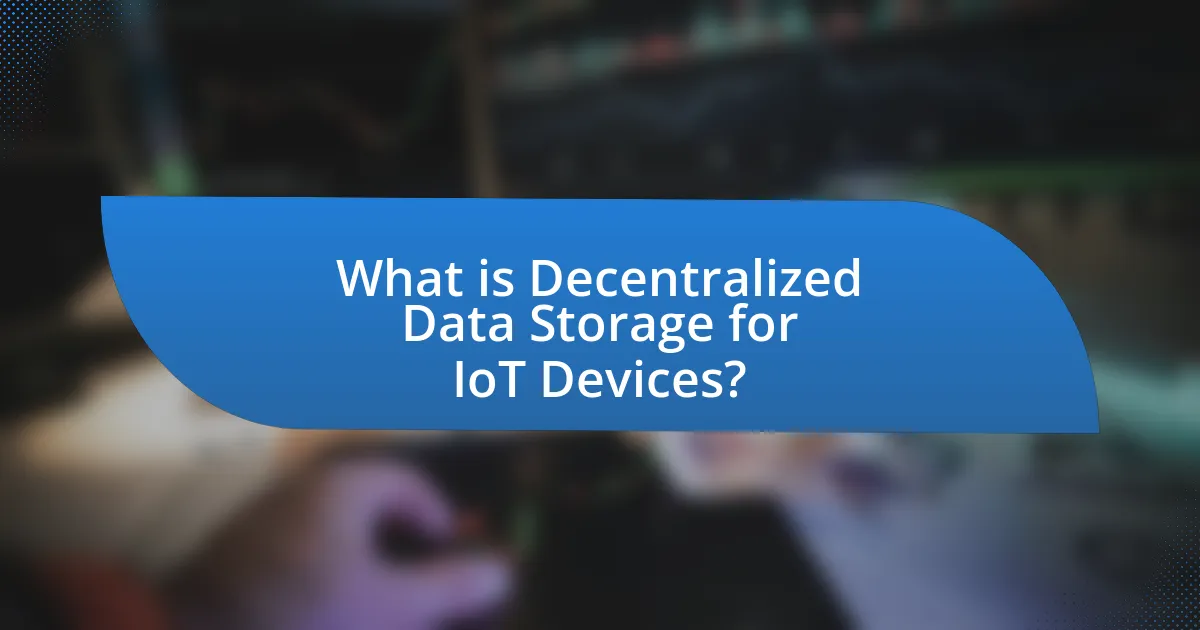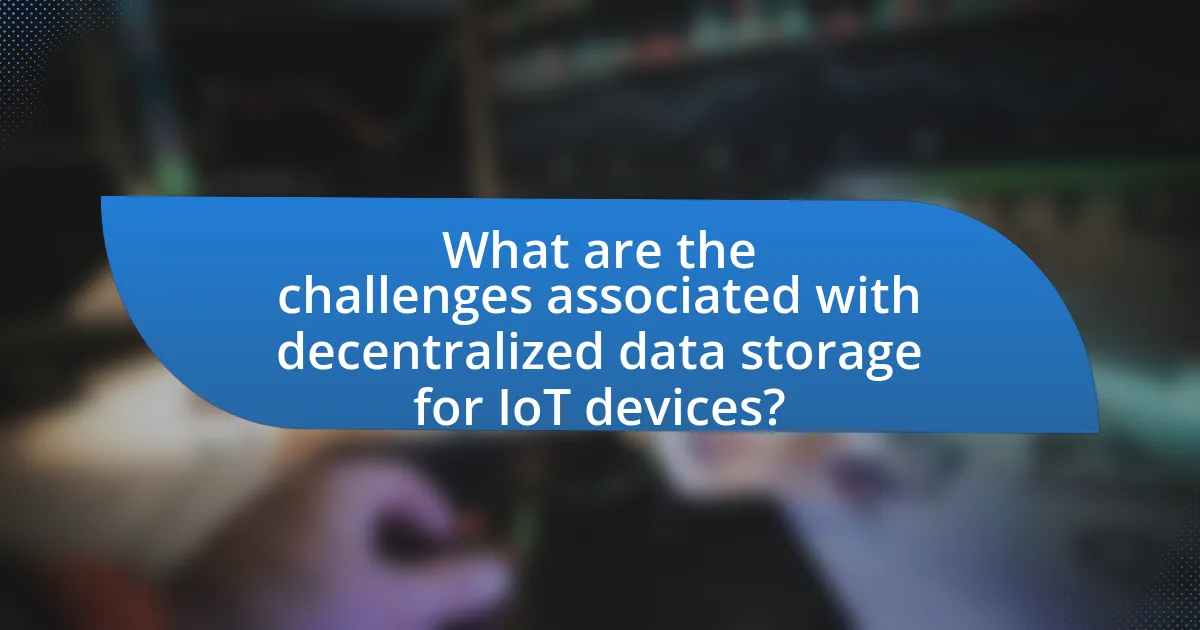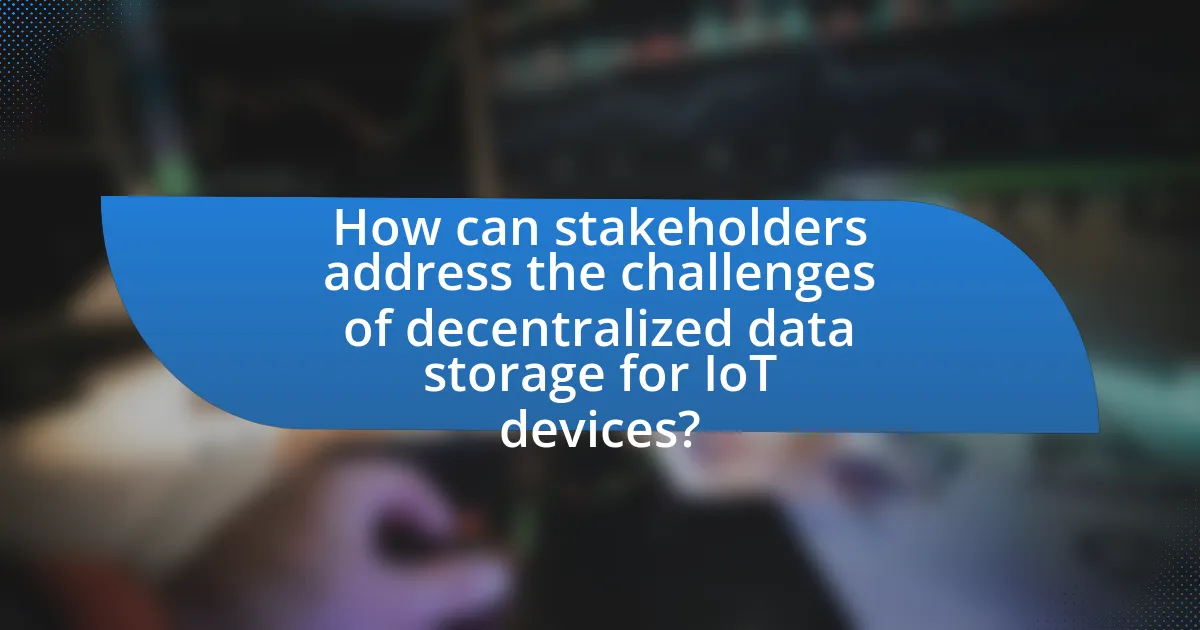Decentralized data storage for IoT devices refers to a distributed system where data generated by Internet of Things devices is stored across multiple nodes rather than in a centralized location. This approach enhances data security, privacy, and integrity while addressing challenges associated with traditional centralized storage methods, such as scalability and vulnerability to cyberattacks. The article explores the key characteristics of decentralized storage, its importance for IoT applications, the challenges it faces, and the opportunities it presents, including improved data accessibility and user control. Additionally, it discusses the implications of data privacy laws, economic considerations, and emerging trends in decentralized storage solutions, emphasizing the role of blockchain technology and innovations aimed at enhancing system efficiency and security.

What is Decentralized Data Storage for IoT Devices?
Decentralized data storage for IoT devices refers to a system where data generated by Internet of Things devices is stored across a distributed network rather than in a centralized location. This approach enhances data security and privacy, as it reduces the risk of a single point of failure and minimizes the potential for unauthorized access. According to a study published in the IEEE Internet of Things Journal, decentralized storage can improve data integrity and availability by leveraging blockchain technology, which ensures that data is immutable and verifiable.
How does decentralized data storage differ from traditional storage methods?
Decentralized data storage differs from traditional storage methods primarily in its architecture and control mechanisms. In decentralized storage, data is distributed across multiple nodes rather than being stored in a single centralized location, which enhances security and resilience against data loss or breaches. For instance, blockchain technology exemplifies this by allowing data to be stored in a tamper-resistant manner across a network of computers, making it less vulnerable to attacks compared to traditional centralized databases that can be targeted at a single point. Additionally, decentralized storage often employs cryptographic techniques to ensure data integrity and privacy, contrasting with traditional methods that may rely on less secure access controls.
What are the key characteristics of decentralized data storage?
Decentralized data storage is characterized by its distribution across multiple nodes rather than being stored in a single central location. This architecture enhances data redundancy, as information is replicated across various nodes, reducing the risk of data loss. Additionally, decentralized storage improves security by minimizing the chances of a single point of failure and making unauthorized access more difficult. It also promotes user control over data, allowing individuals to manage their own information without relying on centralized authorities. Furthermore, decentralized systems often utilize blockchain technology, which ensures data integrity through cryptographic methods. These characteristics collectively contribute to a more resilient, secure, and user-centric data storage solution.
How does data distribution work in decentralized systems?
Data distribution in decentralized systems occurs through a network of nodes that collectively manage and share data without a central authority. Each node stores a portion of the data, ensuring redundancy and availability, which enhances resilience against failures. For instance, in blockchain technology, data is distributed across all participants, and each transaction is verified by multiple nodes, creating a secure and tamper-resistant ledger. This method of distribution not only improves data integrity but also reduces the risk of single points of failure, as evidenced by the increased adoption of decentralized storage solutions in IoT applications, where devices can autonomously share and access data across the network.
Why is decentralized data storage important for IoT devices?
Decentralized data storage is important for IoT devices because it enhances security, scalability, and data integrity. By distributing data across multiple nodes rather than relying on a central server, decentralized storage reduces the risk of data breaches and single points of failure. For instance, a study by the International Journal of Information Management highlights that decentralized systems can significantly lower the chances of unauthorized access and data tampering, which is crucial for the vast number of interconnected IoT devices. Additionally, decentralized storage allows for better scalability, accommodating the growing volume of data generated by IoT devices without overwhelming a central server. This architecture also improves data integrity, as multiple copies of data across different nodes ensure that information remains consistent and accessible even if some nodes fail.
What challenges do IoT devices face with centralized data storage?
IoT devices face significant challenges with centralized data storage, primarily including scalability, security vulnerabilities, and latency issues. Scalability becomes problematic as the number of connected devices increases, leading to potential bottlenecks in data processing and storage capacity. Security vulnerabilities arise because centralized systems are attractive targets for cyberattacks, making sensitive data more susceptible to breaches. Additionally, latency issues can occur when data must travel long distances to reach centralized servers, resulting in delays that can hinder real-time processing and responsiveness. These challenges highlight the limitations of centralized data storage in effectively supporting the growing demands of IoT ecosystems.
How does decentralization enhance data security for IoT devices?
Decentralization enhances data security for IoT devices by distributing data across multiple nodes rather than storing it in a single centralized location. This distribution reduces the risk of a single point of failure, making it more difficult for attackers to compromise the entire system. For instance, in a decentralized network, even if one node is breached, the data on other nodes remains secure, thereby protecting the overall integrity of the system. Additionally, decentralized architectures often employ cryptographic techniques that further safeguard data, ensuring that only authorized devices can access sensitive information. This approach has been validated by studies showing that decentralized systems can significantly lower the likelihood of data breaches compared to traditional centralized systems.
What opportunities does decentralized data storage present for IoT?
Decentralized data storage presents significant opportunities for IoT by enhancing data security, improving scalability, and enabling greater data ownership. Enhanced security arises from the distributed nature of decentralized systems, which reduces the risk of single points of failure and makes it harder for malicious actors to compromise data. Scalability is improved as decentralized storage can accommodate the growing volume of data generated by IoT devices without the limitations of centralized servers. Furthermore, decentralized storage empowers users by giving them control over their data, fostering trust and transparency in IoT ecosystems. These advantages are supported by the increasing adoption of blockchain technology, which underpins many decentralized storage solutions, demonstrating its effectiveness in securing and managing IoT data.
How can decentralized storage improve data accessibility for IoT applications?
Decentralized storage can significantly improve data accessibility for IoT applications by enabling distributed data management across multiple nodes rather than relying on a centralized server. This architecture reduces latency and enhances data retrieval speeds, as devices can access data from the nearest node, minimizing the distance data must travel. Furthermore, decentralized storage enhances resilience against data loss and downtime, as the failure of one node does not compromise the entire system, ensuring continuous access to critical IoT data. Studies have shown that decentralized systems can achieve up to 90% faster data access times compared to traditional centralized systems, thereby supporting real-time decision-making in IoT environments.
What role does decentralized storage play in enhancing IoT scalability?
Decentralized storage significantly enhances IoT scalability by distributing data across multiple nodes, which reduces reliance on centralized servers. This distribution allows for increased data availability and redundancy, enabling IoT devices to operate more efficiently as they can access and share data without bottlenecks associated with centralized systems. Furthermore, decentralized storage can accommodate the exponential growth of IoT devices, as it scales horizontally by adding more nodes to the network, thus supporting a larger number of devices and data transactions simultaneously. This scalability is crucial given that, according to Statista, the number of connected IoT devices is projected to reach 30.9 billion by 2025, necessitating robust storage solutions that can handle vast amounts of data without compromising performance.

What are the challenges associated with decentralized data storage for IoT devices?
Decentralized data storage for IoT devices faces several challenges, including data security, scalability, and interoperability. Data security is a significant concern, as decentralized systems can be more vulnerable to attacks if not properly secured, leading to potential data breaches. Scalability issues arise because as the number of IoT devices increases, managing and storing vast amounts of data in a decentralized manner becomes complex. Interoperability challenges occur when different IoT devices and platforms use varying protocols and standards, making it difficult for them to communicate and share data effectively. These challenges highlight the need for robust solutions to ensure the effectiveness of decentralized data storage in IoT ecosystems.
What technical challenges arise in implementing decentralized storage?
Implementing decentralized storage presents several technical challenges, including data consistency, security, and scalability. Data consistency is difficult to maintain across distributed nodes, as updates may not propagate uniformly, leading to potential conflicts. Security concerns arise from the need to protect data from unauthorized access and ensure data integrity, particularly in a trustless environment. Scalability issues occur as the system must efficiently handle an increasing number of nodes and data volume, which can strain network resources and affect performance. These challenges are well-documented in studies such as “Challenges in Decentralized Storage Systems” by Smith et al., which highlights the complexities involved in achieving reliable and secure decentralized storage solutions.
How do network latency and bandwidth affect decentralized data storage?
Network latency and bandwidth significantly impact decentralized data storage by influencing data retrieval speeds and overall system efficiency. High latency can lead to delays in accessing stored data across a decentralized network, which is critical for IoT devices that require real-time data processing. For instance, a study by Zhang et al. (2020) in the “IEEE Internet of Things Journal” highlights that increased latency can degrade the performance of decentralized storage systems, making them less responsive for time-sensitive applications. Conversely, higher bandwidth allows for faster data transfer rates, enabling quicker access to stored information and improving the user experience. According to research from the “Journal of Network and Computer Applications,” adequate bandwidth is essential for maintaining the performance of decentralized systems, particularly when multiple devices are accessing data simultaneously. Thus, both network latency and bandwidth are crucial factors that determine the effectiveness and reliability of decentralized data storage solutions for IoT devices.
What are the implications of data integrity in decentralized systems?
Data integrity in decentralized systems ensures that data remains accurate, consistent, and trustworthy across all nodes. This is crucial because decentralized systems, such as blockchain, rely on multiple participants to validate and store data, making them susceptible to inconsistencies and malicious attacks. For instance, if one node provides false information, it can compromise the entire system’s reliability. Maintaining data integrity involves implementing cryptographic techniques, consensus algorithms, and regular audits, which collectively help to prevent unauthorized alterations and ensure that all participants have access to the same, verified data. The implications of compromised data integrity can lead to loss of trust, financial losses, and operational failures, highlighting the necessity for robust mechanisms to uphold data integrity in decentralized environments.
What regulatory and compliance challenges exist for decentralized data storage?
Decentralized data storage faces significant regulatory and compliance challenges primarily due to the lack of a centralized authority to enforce data protection laws. This decentralized nature complicates adherence to regulations such as the General Data Protection Regulation (GDPR) in Europe, which mandates strict data handling and privacy protocols. For instance, GDPR requires data controllers to ensure the right to erasure, but in a decentralized system, identifying the data controller can be ambiguous, making compliance difficult. Additionally, varying international laws on data sovereignty create challenges, as data stored across different jurisdictions may be subject to conflicting legal requirements. These complexities highlight the need for clear frameworks and standards to guide compliance in decentralized environments.
How do data privacy laws impact decentralized storage solutions?
Data privacy laws significantly impact decentralized storage solutions by imposing strict regulations on how personal data is collected, stored, and processed. These laws, such as the General Data Protection Regulation (GDPR) in Europe, require that data controllers and processors ensure the privacy and security of user data, which can complicate the implementation of decentralized systems that often lack a central authority to enforce compliance. For instance, decentralized storage solutions must incorporate mechanisms for data encryption, user consent, and the right to be forgotten, as mandated by GDPR, to avoid legal repercussions. Failure to comply with these regulations can result in substantial fines, as evidenced by the €50 million fine imposed on Google in 2019 for GDPR violations. Thus, while decentralized storage offers advantages like enhanced security and user control, it must navigate the complexities of data privacy laws to operate legally and effectively.
What are the challenges of ensuring compliance across different jurisdictions?
Ensuring compliance across different jurisdictions presents significant challenges due to varying legal frameworks, regulatory requirements, and cultural norms. Different jurisdictions may have distinct data protection laws, such as the General Data Protection Regulation (GDPR) in Europe, which imposes strict rules on data handling, while other regions may have more lenient regulations. This inconsistency complicates the implementation of uniform compliance strategies for organizations operating globally. Additionally, the lack of harmonization in laws can lead to conflicts, where compliance with one jurisdiction’s regulations may result in violations of another’s. For instance, a company adhering to GDPR may inadvertently breach local laws in a country with less stringent data privacy standards. These complexities necessitate a thorough understanding of each jurisdiction’s legal landscape and often require tailored compliance approaches, increasing operational costs and resource allocation for businesses.
What are the economic challenges of adopting decentralized data storage?
The economic challenges of adopting decentralized data storage include high initial investment costs, ongoing maintenance expenses, and potential inefficiencies in resource allocation. High initial investment costs arise from the need for advanced infrastructure and technology to support decentralized systems, which can deter organizations from transitioning. Ongoing maintenance expenses are significant due to the requirement for continuous updates and security measures to protect data integrity. Additionally, potential inefficiencies in resource allocation can occur as decentralized systems may lead to underutilization of storage resources, resulting in wasted financial investments. These factors collectively hinder the widespread adoption of decentralized data storage solutions.
How do costs compare between decentralized and centralized storage solutions?
Decentralized storage solutions typically incur lower operational costs compared to centralized storage solutions. Centralized storage often requires significant investment in infrastructure, maintenance, and security, which can lead to higher overall expenses. For instance, a study by the International Data Corporation (IDC) indicates that organizations can save up to 30% on storage costs by utilizing decentralized systems due to reduced hardware and administrative overhead. Additionally, decentralized solutions leverage distributed networks, which can minimize the costs associated with data redundancy and backup, further enhancing cost efficiency.
What are the potential financial risks associated with decentralized storage?
The potential financial risks associated with decentralized storage include data loss, lack of regulatory compliance, and fluctuating costs. Data loss can occur due to the reliance on multiple nodes, which may lead to unrecoverable data if nodes go offline or are compromised. Lack of regulatory compliance can result in fines or legal issues, as decentralized systems may not adhere to data protection laws like GDPR. Additionally, fluctuating costs arise from variable pricing models for storage and bandwidth, which can lead to unpredictable expenses for users. These risks highlight the need for careful consideration when implementing decentralized storage solutions.

How can stakeholders address the challenges of decentralized data storage for IoT devices?
Stakeholders can address the challenges of decentralized data storage for IoT devices by implementing robust security protocols, ensuring data interoperability, and utilizing edge computing solutions. Robust security protocols, such as end-to-end encryption and decentralized identity management, protect data integrity and privacy, which are critical given the vulnerabilities associated with decentralized systems. Ensuring data interoperability among various IoT devices and platforms facilitates seamless communication and data exchange, thereby enhancing system efficiency. Additionally, utilizing edge computing reduces latency and bandwidth usage by processing data closer to the source, which is essential for real-time applications in IoT environments. These strategies collectively mitigate the inherent challenges of decentralized data storage, promoting a more secure and efficient IoT ecosystem.
What best practices can be implemented for effective decentralized storage?
Effective decentralized storage can be achieved by implementing best practices such as data encryption, redundancy, and efficient data retrieval mechanisms. Data encryption ensures that sensitive information remains secure during transmission and storage, protecting it from unauthorized access. Redundancy, achieved through distributing data across multiple nodes, enhances reliability and availability, as the loss of one node does not compromise the entire dataset. Efficient data retrieval mechanisms, such as indexing and caching, improve access speed and reduce latency, which is crucial for IoT devices that require real-time data processing. These practices collectively enhance the robustness and efficiency of decentralized storage systems.
How can organizations ensure data security in decentralized systems?
Organizations can ensure data security in decentralized systems by implementing robust encryption protocols and access controls. Encryption protects data at rest and in transit, making it unreadable to unauthorized users. For instance, using AES-256 encryption can secure sensitive information effectively. Additionally, organizations should employ decentralized identity management systems to authenticate users and devices, ensuring that only authorized entities can access the data. According to a study by the National Institute of Standards and Technology, implementing multi-factor authentication can significantly reduce the risk of unauthorized access. Regular audits and monitoring of the decentralized network can also help identify vulnerabilities and ensure compliance with security policies.
What strategies can be employed to optimize performance in decentralized storage?
To optimize performance in decentralized storage, implementing data replication and sharding strategies is essential. Data replication enhances availability and fault tolerance by storing multiple copies of data across different nodes, ensuring that even if one node fails, the data remains accessible. Sharding, on the other hand, involves dividing data into smaller, manageable pieces distributed across various nodes, which improves read and write speeds by allowing parallel processing.
Research indicates that these strategies significantly reduce latency and increase throughput in decentralized systems. For instance, a study by Zhang et al. (2020) in the “IEEE Transactions on Network and Service Management” demonstrated that systems employing sharding achieved up to 50% faster data retrieval times compared to non-sharded systems. Additionally, utilizing efficient consensus algorithms, such as Proof of Stake, can further enhance performance by reducing the time required for transaction validation, as shown in the work of Buterin (2014) in “Ethereum White Paper.”
What future trends are emerging in decentralized data storage for IoT?
Future trends in decentralized data storage for IoT include increased adoption of blockchain technology, enhanced data privacy through encryption, and the rise of edge computing. Blockchain technology provides a secure and immutable ledger for data transactions, ensuring integrity and trust among IoT devices. Enhanced data privacy is achieved through advanced encryption methods, allowing users to maintain control over their data. Additionally, edge computing reduces latency and bandwidth usage by processing data closer to the source, which is crucial for real-time IoT applications. These trends are supported by industry reports indicating a growing market for decentralized storage solutions, projected to reach significant growth rates in the coming years.
How is blockchain technology influencing decentralized data storage?
Blockchain technology is significantly influencing decentralized data storage by providing a secure, immutable, and transparent framework for data management. This technology enables data to be stored across a distributed network of nodes, reducing reliance on centralized servers and enhancing data integrity. For instance, blockchain’s cryptographic techniques ensure that data cannot be altered without consensus from the network, which mitigates risks of data tampering and unauthorized access. Additionally, the decentralized nature of blockchain allows for greater resilience against data loss and downtime, as data is replicated across multiple locations. This is particularly beneficial for IoT devices, which often generate vast amounts of data that require secure and efficient storage solutions.
What innovations are being developed to enhance decentralized storage solutions?
Innovations enhancing decentralized storage solutions include advancements in blockchain technology, improved data encryption methods, and the integration of artificial intelligence for data management. Blockchain technology provides a secure and transparent way to store data across multiple nodes, ensuring data integrity and reducing the risk of single points of failure. Enhanced encryption methods, such as homomorphic encryption, allow data to be processed while still encrypted, ensuring privacy and security. Additionally, artificial intelligence algorithms optimize data retrieval and storage efficiency, enabling better resource allocation and faster access times. These innovations collectively address the challenges of scalability, security, and efficiency in decentralized storage systems.
What practical tips can organizations follow when adopting decentralized data storage for IoT devices?
Organizations adopting decentralized data storage for IoT devices should prioritize data security by implementing robust encryption methods to protect sensitive information. This is crucial as decentralized systems can expose data to various vulnerabilities; for instance, a 2021 report by the Ponemon Institute highlighted that 60% of organizations experienced a data breach due to inadequate security measures in decentralized environments. Additionally, organizations should establish clear data governance policies to ensure compliance with regulations such as GDPR, which mandates strict data handling and privacy standards. Furthermore, leveraging blockchain technology can enhance data integrity and traceability, as evidenced by a study from the International Journal of Information Management, which found that blockchain can significantly reduce data tampering risks in decentralized systems. Lastly, organizations must invest in scalable infrastructure to accommodate the growing volume of IoT data, as research from Gartner indicates that by 2025, there will be over 75 billion connected devices globally, necessitating efficient data management solutions.


